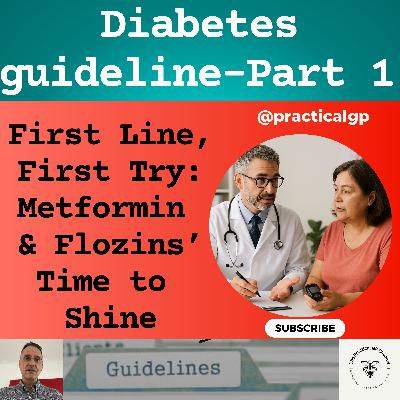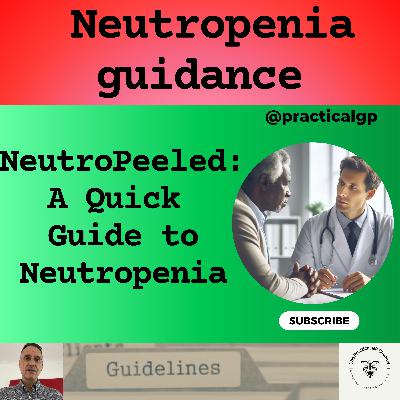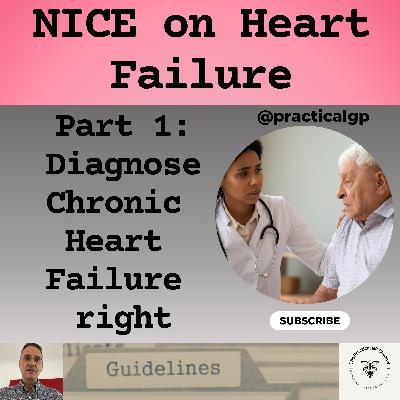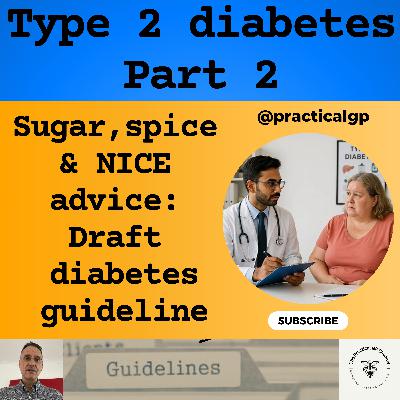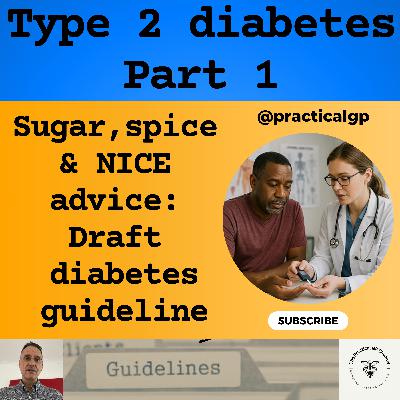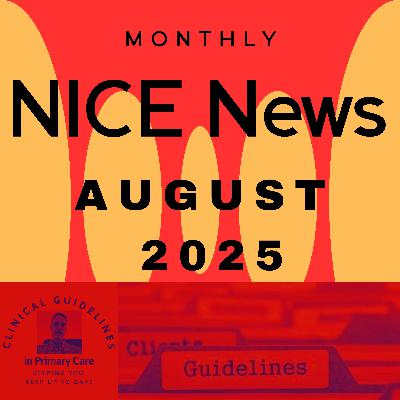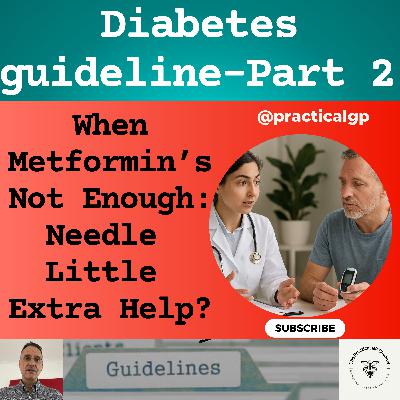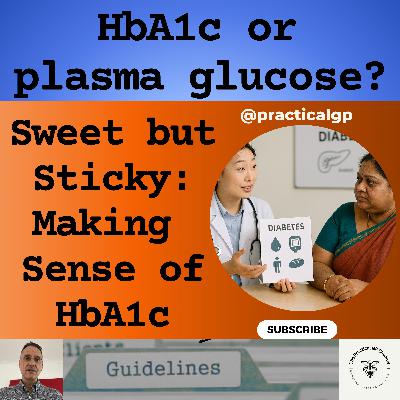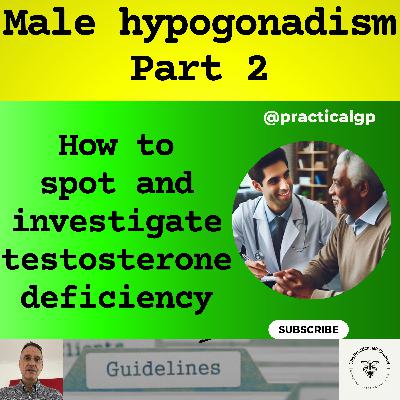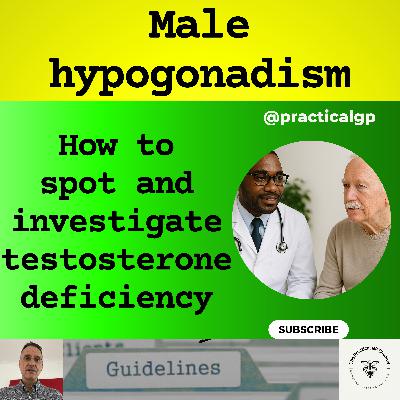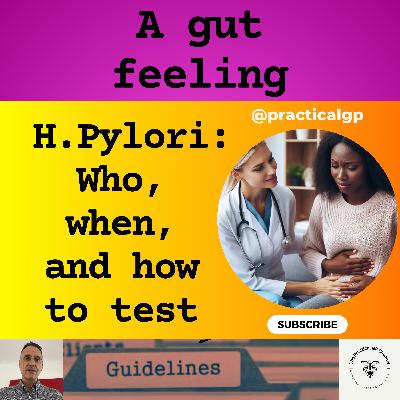Podcast - T2DM guideline Part 1 -First Line, First Try: Metformin and Flozins’ Time to Shine
Description
The video version of this podcast can be found here:
· https://youtu.be/32Lf5UlyTOA
This episode makes reference to guidelines produced by the "National Institute for Health and Care Excellence" in the UK, also referred to as "NICE". The content on this channel reflects my professional interpretation/summary of the guidance and I am in no way affiliated with, employed by or funded/sponsored by them.
NICE stands for "National Institute for Health and Care Excellence" and is an independent organization within the UK healthcare system that produces evidence-based guidelines and recommendations to help healthcare professionals deliver the best possible care to patients, particularly within the NHS (National Health Service) by assessing new health technologies and treatments and determining their cost-effectiveness; essentially guiding best practices for patient care across the country.
My name is Fernando Florido and I am a General Practitioner in the United Kingdom. In this episode I go through the NICE recommendations on the drug treatment of type 2 diabetes, included in the NICE guideline NG28. The links to the NICE guideline can be found below.
In today’s episode, we are focusing on the first line drug management. In the next episode, we will cover treatment options if further interventions are needed.
I am not giving medical advice; this video is intended for health care professionals, it is only my summary and my interpretation of the guidelines and you must use your clinical judgement.
Disclaimer:
The Video Content on this channel is for educational purposes and not intended to be a substitute for professional medical advice, diagnosis, or treatment. Always seek the advice of your physician or other qualified health provider with any questions you may have regarding a medical condition. Never disregard professional medical advice or delay in seeking it because of something you have read or seen on this YouTube channel. The statements made throughout this video are not to be used or relied on to diagnose, treat, cure or prevent health conditions.
In addition, transmission of this Content is not intended to create, and receipt by you does not constitute, a physician-patient relationship with Dr Fernando Florido, his employees, agents, independent contractors, or anyone acting on behalf of Dr Fernando Florido.
Intro / outro music: Track: Halfway Through — Broke In Summer [Audio Library Release]
- Music provided by Audio Library Plus
- Watch: https://youtu.be/aBGk6aJM3IU
- Free Download / Stream: https://alplus.io/halfway-through
There is a podcast version of this and other videos that you can access here:
Primary Care guidelines podcast:
· Redcircle: https://redcircle.com/shows/primary-care-guidelines
· Spotify: https://open.spotify.com/show/5BmqS0Ol16oQ7Kr1WYzupK
· Apple podcasts: https://podcasts.apple.com/gb/podcast/primary-care-guidelines/id1608821148
There is a YouTube version of this and other videos that you can access here:
- The Practical GP YouTube Channel:
https://youtube.com/@practicalgp?si=ecJGF5QCuMLQ6hrk
The NICE guideline on Type 2 diabetes in adults: management [NG28] can be found here:
· https://www.nice.org.uk/guidance/ng28
Transcript
If you are listening to this podcast on YouTube, for a better experience, switch to the video version. The link is in the top right corner of the video and in the episode description.
Hello and welcome! I’m Fernando, a GP in the UK. In this episode, we’ll go through the NICE recommendations on the drug treatment of type 2 diabetes, included in the NICE guideline NG28. The link to it is in the episode description.
In today’s episode, we are focusing on the first line glucose-lowering drugs. In the next episode, we will cover treatment options if further interventions are needed.
Right, let’s jump into it.
And before we look at regular glucose-lowering drugs, we first need to check whether rescue therapy is required, remembering that it can be necessary at any stage of treatment.
If the patient has symptoms of hyperglycaemia, we’ll consider starting insulin or a sulfonylurea, then review the treatment once blood glucose control is achieved. In symptomatic patients, the priority is to bring glucose levels down quickly to prevent complications and improve wellbeing. Because insulin and sulfonylureas lower blood glucose faster than most other diabetes medications, we’ll use these first, and once control is restored, switch to more suitable long-term treatment.
After that, we’ll move on to first-line regular drug treatment. The usual starting point is standard-release metformin. After starting a low dose, we will increase the dose gradually over several weeks to reduce the risk of gastrointestinal side effects, and if those occur, we can switch to a trial of modified-release metformin.
Metformin is recommended first because it’s been shown in large clinical trials to lower blood glucose with a low risk of hypoglycaemia, and it doesn’t promote weight gain. The UK Prospective Diabetes Study — or UKPDS — found that in people with type 2 diabetes who were overweight, metformin not only improved blood glucose control, but also reduced the risk of diabetes-related complications. Importantly, it also lowered their cardiovascular risk and overall mortality. These benefits, together with its long track record of safety, make metformin the preferred first-line treatment for most patients.
At the same time that we start metformin, we’ll assess the patient’s cardiovascular status and risk. The goal is to determine whether they have chronic heart failure, established atherosclerotic cardiovascular disease, or are at high risk of developing it.
We need to remember that established atherosclerotic cardiovascular disease includes conditions such as coronary heart disease, acute coronary syndrome, previous myocardial infarction, stable angina, ischaemic stroke or TIA, and peripheral arterial disease.
We also need to be aware that a high cardiovascular risk means a QRISK score above 10% in anyone aged 40 or over, or, for those under 40, having any one of these factors: hypertension, dyslipidaemia, smoking, obesity, or a family history in a first-degree relative of premature cardiovascular disease.
If the patient has chronic heart failure, established atherosclerotic cardiovascular disease, or is at high risk of developing cardiovascular disease, we’ll offer an SGLT2 inhibitor in addition to metformin — and we’ll do this regardless of their HbA1c level.
This approach is supported by strong evidence. Large randomised controlled trials, have shown that SGLT2 inhibitors not only improve blood glucose control but also reduce the risk of hospitalisation for heart failure, and in some cases lower cardiovascular mortality. These benefits are seen even in patients without diabetes, which highlights their role in protecting the cardiovascular system as well as the kidneys.
Now, when starting dual therapy with metformin and an SGLT2 inhibitor as first-line treatment, we’ll introduce the drugs sequentially. We will start with metformin first, then check tolerability, and then add the SGLT2 inhibitor as soon as metformin is confirmed to be well tolerated.
If metformin is contraindicated or not tolerated, our approach will also depend on the patient’s cardiovascular history and risk.
If they have chronic heart failure, established atherosclerotic cardiovascular disease, or are at high risk of developing it, we’ll offer an SGLT2 inhibitor as monotherapy. We do this because of the SGLT2 inhibitors cardiovascular benefits.
If the patient is not in any of these higher-risk groups, we can consider any other glucose-lowering treatments. Options include:
- a DPP-4 inhibitor
- pioglitazone
- a sulfonylurea
- or an SGLT2 inhibitor.
In order to make the right choice of drug, it may be a good idea here to give a comparative overview based on their effect on weight, hypoglycaemia risk etc.
And let’s start with weight. Although metformin was once thought to cause weight loss, NICE now describes it as weight neutral. DPP-4 inhibitors, or gliptins, are also generally weight neutral, meaning they usually don’t cause significant weight gain or loss. In contrast, SGLT2 inhibitors—also called flozins—tend to promote weight loss, which can be especially helpful for patients who are overweight or need to lower their cardiovascular risk. On the other hand, both Pioglitazone and Sulfonylureas are linked with weight gain, something to watch out for, particularly in patients where added weight could worsen insulin resistance or raise cardiovascular risk.
In terms of hypoglycaemia risk. Metformin, DPP-4 inhibitors, Pioglitazone, and SGLT2 inhibitors all carry a low risk of hypoglycaemia. However, Sulfonylureas stand out here with a much higher risk, especially in older adults or those with irregular meal pattern

